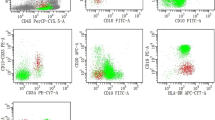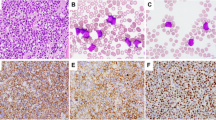Abstract
Cell proliferation rate is a well-established prognostic factor in cancer, but it has not been considered to identify the risk group of childhood acute lymphoblastic leukaemia (ALL) at presentation. We carried out a study to demonstrate the prognostic importance of the rapidity of cell proliferation in patients with ALL. To measure the rapidity of cell proliferation we used the parameter relative to the area of silver-stained nucleolar organiser regions (AgNORs) as evaluated by morphometric analysis on smeared marrow blast cells. The mean AgNOR area of leukaemic marrow cells was measured in 119 children. By using a cut-off value of 3 microns2, we identified a group of 91 children with low proliferating blast activity (mean AgNOR value 2.11 microns2) and a group of 28 children with high proliferating activity (mean AgNOR value 3.29 microns2). The group of patients with a mean AgNOR value > 3 microns2 was characterised by a higher number of deaths, more frequent relapse and shorter time interval to relapse than the group of patients with mean AgNOR value < 3 microns2 (P < 0.01). Multivariate analysis performed to include T-cell immunophenotype, FAB morphology, leucocyte count and presence of mediastinal mass showed that the mean AgNOR value was the only independent predictor of unfavourable event-free survival probability (P > 0.01). Our results indicate that the rapidity of marrow blast cell proliferation is an important prognostic parameter in childhood ALL and should be routinely introduced in the group risk definition.
This is a preview of subscription content, access via your institution
Access options
Subscribe to this journal
Receive 24 print issues and online access
$259.00 per year
only $10.79 per issue
Buy this article
- Purchase on Springer Link
- Instant access to full article PDF
Prices may be subject to local taxes which are calculated during checkout
Similar content being viewed by others
Author information
Authors and Affiliations
Rights and permissions
About this article
Cite this article
Trerè, D., Pession, A., Basso, G. et al. Prognostic relevance of pretreatment proliferative rapidity of marrow blast cells in childhood acute lymphoblastic leukaemia. Br J Cancer 70, 1198–1202 (1994). https://doi.org/10.1038/bjc.1994.473
Issue Date:
DOI: https://doi.org/10.1038/bjc.1994.473
This article is cited by
-
Mitosis-targeted anti-cancer therapies: where they stand
Cell Death & Disease (2012)
-
Prognostic value of the rapidity of bone marrow blast cell proliferation in adult acute lymphoblastic leukemia
Leukemia (2004)



